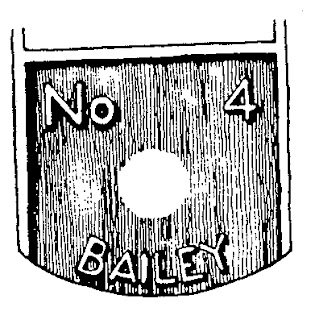Instead of re-building my whole Illustrated Type Study of Stanley Bench planes, for now. I will just go over the period of interest in order to show how you use such a list to zero in on a definite type. Well, no such thing as "definite" but definitively "pretty sure"...
I'll say it again, these Type Studies by collectors are only as good as based on the size of a large number of specimens, and the manufacturers never bother to help future collectors, they recycled often cut illustrations in their publicity and catalogs.
That meant re-using old images, not the current model, and were known to used up previous inventories of parts, wherever possible. Both in an effort of cost savings...
My two No 7s, in front Type 13, in back Type 9
The one we will be examining is the Bailey No 7 Jointer, I recently acquired.
That is part of my indoctrination of any "new" tool entering my temporary custody.
Clean, assess, research
Document;
- provenance
- pictures as found then after restoration
I often document the process for my future references
- anything I found about it;
catalog copy, maker's history, auction results or screen shot of current price
Etc.
The vendor had a sticker on it mentioning the date of 1907
A cursory look over, the frog surface, the dates of patents on it, no frog screw adj, low knob etc, all pointed toward the same vintage, so I did not questioned it, I just quickly look up where 1907 falls in the Type study: Type 9 1902-07 and proclaimed it earlier in a previous post. Now lets see if the seller and I still agree when looking closer.
No 7 Jointer, 22"L, 2 3/8"W, 8 1/8lbs, 1869-1970.
No 7C Jointer, 22"L, 2 3/8"W, 8 1/8lbs,
1898-1964.
Mine is corrugated so it cannot be before 1898.
All the features of the previous, except:
That means we have to look back in order to see what else to look for.
I first quickly look for a major feature changes like the Frog screw adjustment (Type 10), First lateral lever (Type 5), Height of front knob, Frog receiver changes etc.
In our case, we see that the first lateral lever came up at Type 5 1885-1888.
That would be with the one piece lateral adjuster tip
What we have is the two pieces lateral adjuster, the one with the rotating disk at the end
That started at Type 6 1888-1892.
It also had 3 patent dates on it: 2-8-76, 10-21-84, and 7-24-88
By type 8 only the last patent date remains 7-24-88
That is what we have, so it look like it is Type 8 and above
The frog receiver is always the best indicator of its type.
We have 2 patents date on the bed casting (Type 9) and no frog adj. screw, which started at Type 10. We are then between Type 8 and 9
That central rib introduced with Type 9 is meant to help center the frog square to the mouth while adjusting the mouth aperture. The next obvious feature was to add a screw to adjust it (Type 10)
Frog now have a slot at the bottom for the central rib.
One on Left is our No 7 Type 9, the one on Right is Type 13
Notice also the size difference between the Brass depth adjuster
At Type 9 they started to put BAILEY name on the front toe
Start at Type 9
This is one place were we have to deviate slightly from the Type study since ,
the vast majority, unless otherwise specified, were made for the No 4 Smoother.
No 5, 6, 7 and 8 being longer have their Nos cast at the heel instead. Nonetheless, Bailey did not appear on their castings before Type 9
Bailey cast up front on the toe
Two patents Nos appears on the casting, right behind the frog and the rear tote and there is no screw to adjust the frog from the rear.
PAT'D
MAR- 25- 02
AUG-19-02
The front knob is of the low type
Low type knob
High type knob
Start at Type 12 1919-24
It is also about that time that the brass nuts holding the knob and tote start to change from a cylindrical form to one with a waist on them. That was to minimize the nut sticking into the wood.
Cropped from an earlier pic.
The one on the left shows the slim waist while the other still has the cylindrical form. You sometimes run into both types on a plane. Not this specimen.
The blade logo can be dated by looking at Bob Kaune study
1909-1912
So everything points to a Type 9, with the sole exception of the Pat no still present on the lateral lever (Type 8) no doubt a left over plane parts, making this plane probably early in the Type 9 production time frame of 1902-1907.
Bob, who should be finished with his illustrated Type Study soon, stay tuned...
















This comment has been removed by a blog administrator.
ReplyDeleteThank you Jonathan
ReplyDeleteExcellent post Bob, I cannot wait for the illustrated type study.
ReplyDeleteGerhard
Bob "Sherlock" Demers is on the case. Nicely done. I'll look forward to the illustrated type study. I've often thought that was sorely missing from the Blood and Gore study.
ReplyDeleteLOL Matt, thanks. Me too that is why i first done it years ago. Im almost done, finding all the pics I need. Coming up soon
ReplyDelete